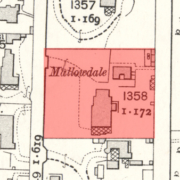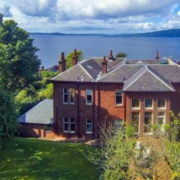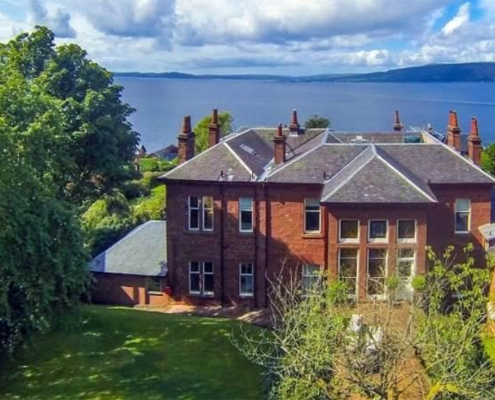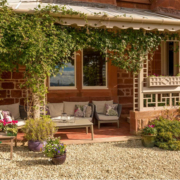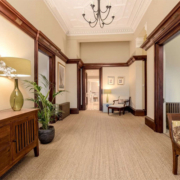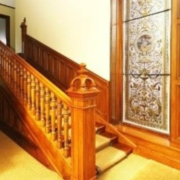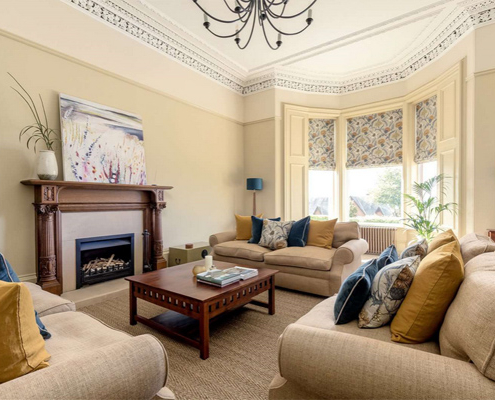9 Montgomerie Terrace, Skelmorlie
Photos. 1. Mallowdale circa 1970 – courtesy of previous owner. 2. 1910 Ordinance Survey. 3. Arial view of Mallowdale taken from the North – Savills 2022. 4. Mallowdale taken from West – Savills 2022. 5. Mallowdale taken from East – Savills 2015. 6. Mallowdale veranda – Savills 2022. 7. Mallowdale downstairs entrance hallway – Savills 2022. 8. Continuation of Mallowdale’s downstairs hallway – Savills 2022. 9. Mallowdale’s mid landing and stained glass windows , now entrance to upper house – Savills 2015. 10. Mallowdale’s staircase – Savills 2015. 11. Mallowdale lower lounge and fireplace – Savills 2022. 12. Mallowdale’s upper reception room and fireplace – Savills 2015. 13. Further reception room and fireplace in upper property – Savills 2015.
| Owners | Dates | Alterations |
|---|---|---|
| The Earl of Eglinton & Winton | Pre 1874 | Landowner |
| Mr John Innes | 1874 – 1881 | House built by John Innes in 1874. Architect – John Honeyman* |
| Mr William H Hunter / The Trustees of Peter Wright | 1881 – 1893 | Alterations including addition of conservatory. |
| Mr & Mrs Duncan Sillars | 1893 – 1903 | |
| Mr & Mrs Walter Hamilton | 1903 – 1927 | |
| Mrs Victoria Mayberry or MacKay | 1927 – 1935 | |
| Mrs Mabel A Miller | 1935 – 1946 | |
| Mr & Mrs Robert J Howatson | 1946 – 1941 | |
| Mrs Helen Blackhall or Brown | 1951 – 1951 | |
| Mr James G Davie | 1951 – 1956 | |
| Mr Robert H Torrance | 1956 – 1957 | |
| Mr Andrew S Wilson | 1957 – 1962 | House split horizontally into two properties (upper and lower) |
* Source: Dictionary of Scottish Architects design report. www.scottisharchitects.org.uk/
About the House:
In May 1874, the Right Honourable Archibald William Montgomerie, Earl of Eglinton and Winton feued 1 acre and 20 poles of ground to John Innes, builder, Skelmorlie. [1]
From other documents, we learn that John Innes did not just contract for the land on which he then built Mallowdale but bought five adjoining plots on Montgomerie Terrace. From the deeds and known owners, we know that three of these were Everlie (The Beeches), Innes Villa (Mallowdale) and Westpark. [1][7]
Innes Villa (Mallowdale) is “bounded on the west by Montgomerie Terrace along which it extends two hundred feet, or thereby, on the north by ground disponed by me to Clement Bagshaw, along which it extends two hundred and forty six feet, or thereby, to the east by Eglinton Terrace along which it extends two hundred feet, or thereby, and on the south to land disponed by me to John Caldwell, builder of Largs along which it extends two hundred and fifty feet or thereby. [1]
Author’s Note: The other two plots were most likely where The Manse (Ellanbank) 1874 and Alipore (Glendower) were built.
It is almost certain that John Innes hired John Honeyman, the renowned Glasgow architect to build Innes Villa (Mallowdale). Honeyman had been involved with the village from the start. His first architectural assignment was Skelmorlie Bank (Shore Road) in 1866. A year later, he designed Chaseley on Shore Road and in 1868 he built his own house Stroove on Montgomerie Terrace. By 1973, Honeyman’s commissions in Skelmorlie were at their peak. He designed Everlie /(The Beeches) next door to Innes Villa (Mallowdale), Oakhill on the other side of Montgomerie Terrace, three houses down and Skelmorlie House on the north corner of the Crescent and Sandybrae Road. In 1974, he designed the encapsulation of Morland House on the Long Hill, Skelmorlie Manse (Ellanbank), and “Innes Villa”. [2]
Although the list of properties designed by John Honeyman, provides no more detail than, “Innes Villa”, a house for John Innes in 1874, it is too coincidental to be anything other than what we know today as Mallowdale. [2]
Surprisingly, Innes Villa (Mallowdale) is not a listed building. [2]

Photo source: Savills 2022, 2. Savills 2022, 3. 1910 Ordinance Survey
Like most villas in the village, the house is constructed of red sandstone over two floors with a slate roof. From early advertisements we know the original building included 3 public rooms, 6 bedrooms and 3 good size dressing rooms and had a separate building containing stables, a coach house and harness room (see photo 3 above). [3]
Over the years there have been alterations to the main building……
Between the 1880s and 1890, the house was extended substantially to the south, evidenced by the thickness of interior walls and the roof line (photo 1)). This extension included square bay windows on the southwest corner and a conservatory (with boiler room below) which ran the full breadth of the house. The conservatory doesn’t exist today but it’s footprint can be seen on the 1910 ordinance survey (see hatched areas in photo 3). [3]
The main door of the house is towards the north end of the west side of the building. At some point prior to 1910, probably at the same time as the extension to the south, a veranda was added to protect occupants from the rain as well as provide shade and an outdoor seating area in the summer (photo 2). [3]
A further early addition was the servants’ quarters to the north end of the property [3]
At the rear, the house has been extended outwards (by 3 metres) in line with the internal staircase (photos 1 and 2 below). The ground floor of this extension has five sash-and-case, stained glass windows (photo 3), and the upper floor has seven 6-metre-high, floor-to-ceiling, stained-glass windows, mid landing (photo 4 and 5). As the stained-glass matches those in the downstairs doors and there is evidence in the internal plaster lines of an earlier staircase, we know this was an addition to the house, not part of the original. [3]

Photo source:: 1. Savills 2015, 2. and 3. MY/ND – 2023, 4. and 5. Savills 2015.
As well as the stained-glass windows, veranda and bow windows visible from the outside, there are many special architectural features inside. [3]
Entering the house through the main door there is a porch with a stunning stained-glass windowpane on the inner door (photo 1 below) which matches the stained glass at the rear of the house. There is also a matching door on the south side which would have led out to the conservatory at some point. [3]

Photo source: 1. MY/ND – 2023, 2. Savills 2022, 3. MY/ND – 2023
From the porch, the hallway runs across the house west to east to the foot of what would have been the staircase (photo 2) and then turns right and runs north to south (photo 4). The hallway doors, facings, skirtings, and staircase are all made of teak. There is also an intricate teak cornice with copper Macintosh style plaques (photo 3) inlaid every 3-4 feet along its length. [3]
It’s believed that the staircase and panelling were produced in one of the shipyards. Two retired shipyard French polishers advised the owners that the staircase had been made in one of the shipyards and that there would be an invoice number etched on the inside of the banister, three stairs from the top. Innes Villa/Mallowdale had such a number exactly as described. [3]
Authors Note: Apparently, in bygone years, shipyard and ship owners had furniture made for them and then charged to the ship.
The hallway, porch and public rooms all have highly decorative mouldings and ceiling roses. A good example of this can be seen where the original house and extension to the south have been joined (see photo 1 below). [3]
All the rooms including bedrooms would have once had one or more fireplaces. Innes Villa (Mallowdale) has 26 chimney flues! Most of the fireplaces and overmantels have now been removed or covered but a couple of fine examples remain (photo 2 and 3 below). [3]

Photo source: 1. Mallowdale’s decorative cornice – MY/ND – 23, 2. Savills 2015, 3 MY/ND – 23
It is believed that Mallowdale was split into upper and lower conversions around 1961 when the then owner applied to the Earl of Eglinton and Winton to waive, allocate and augment the Fue Duty of the house. Apart from the repurposing of certain rooms, the split was achieved quite simply by flooring over the lower half of the staircase and making a door in the stained-glass panelling at the rear of the house for the upper conversion. [3]
A further minute of waiver was issued by The Right Honourable Archibald George Montgomerie in favour of Thomas Burns Smith and Mrs Catherine Smith in October 1989. The document itself is missing but would be during the time that Doctor Weedon owned the downstairs flat and is likely to relate to the sale of land on the south side of the property to Mr and Thomas Mrs Smith who subsequently built on the site. [42]
In 1995, what was remaining of the conservatory (the sandstone brickwork) was removed and replaced by a double garage. [3]
About the Owners
1874 – 1881 John Innes
John Innes was born in 1833 in Ireland and without a more specific place of birth, we’ve been unable to find records relating to his early years. We pick up the story at his wedding to Kate Wilson on 18 February 1867 held in her parents’ house in Hutchesontown, Glasgow. From the marriage certificate we learn that John was then 34 years old, a widower and the son of David and Elizabeth (Lundy) Innes. Kate, who is later known as Catherine was 25 and the daughter of Alexander and Catherine McKechnie.[4]
That same year, the couple’s first child, John Wilson Innes was born on 6 December at Springbank (Shore Road), Skelmorlie. At that time John was a master builder. [5]
Just over a year later Catherine McKechnie Innes was born in February 1869 at Hope Villa, also known as Auchendarroch House, Skelmorlie. [5]
In 1871, the family are still at the 5 roomed Auchendarroch House on the High Road (now Skelmorlie Castle Road). From the census we learn that John, by then 39, was employing 10 men and 2 boys. Also listed in the census, was his wife, Catherine (Kate), then 29, their son John Wilson Innes, then aged 3, their daughter Catherine McKechnie Innes, then aged 2, their niece in law, Catherine Thomson, aged 11 and Sarah Murphy, aged 16, domestic Servant from Dumbarton. [6]
We know from one of the ancestry sites, that the couple went on to have one other child, a daughter, born in September 1873, at Upper Skelmorlie. Initially, she was named Agnes Innes but six months later she was renamed/reregistered as Elizabeth Innes. [5]
The same year that Elizabeth was born, John Innes commissioned John Honeyman to design Skelmorlie House on the corner of the Cresent and Sandybrae Road. [2]
Author’s Note: To date, we haven’t been able to discover John Innes’s connection with Skelmorlie House and therefore don’t know whether he owned the land and the house which was subsequently built on it or whether he was acting as a middleman for someone else.
A year later in 1874, John purchased five plots of land on the east side of Montgomerie Terrace, from the Earl of Eglinton and Winton. He proceeded to sell four of these, leaving himself with the plot on which Mallowdale was subsequently built and with an annual feu duty of £15. [1] [7]
Author’s Note: We assume that a deal was stuck between Clement Dixon and John Innes awarding the masonry contract for Everlie (The Beeches) in 1874 to the latter on the back of the sale of the land.
From the 1875 valuation roll, we learn that John Innes was still living at Auchendarroch House which he was renting from a David Baillie who also owned and rented many other houses in the village. John Innes did own his own property on the High Road, which was rented out to 19 men and 2 women at a rate of £6 – £12 per person per annum. The tenants were some of the key workers in the village, i.e., labourers, masons, joiners, gardeners, etc. [6]
Author’s Note: It’s almost certain that this property is what was later known as “Innes Park Buildings” or “The Diggings”.
In the same valuation roll, John is also listed as occupier of Beithglass quarry and part occupier of Annet Yard, both of which were owned by the Earl of Eglinton and Winton. There is no reference in the valuation roll to any of the new houses that John was involved with, i.e., Skelmorlie House, Everlie or Mallowdale. Presumably this is because they weren’t yet habitable. [6]
Later that same year (1875), John’s wife Catherine died at home, Auchendarroch, with John at her bedside. The children would have been 8, 6 and 2 years old. [4]
In September 1877, John borrowed £2,400 from the Real Estate Security Company using Mallowdale house and grounds as collateral.[1]
A year later, John Innes is listed under the ‘Joiner’ section of the post office directory as “John Innes (builder), Skelmorlie House”. Earlier we referred to his connection with Skelmorlie House, but we don’t know if he owned the property in 1878, whether he was living there or whether he was just using it as an advertising address. [8]
The next reference is found in the Mallowdale papers, “Schedule of intimation, acquisition and protest at the instance of the Real Estate Security Company against John Innes”. In this document the Real Estate Security Company gave “notice to John Innes, now or lately, builder at Skelmorlie” to repay the full loan of £2,400 plus £35 of outstanding interest. The document dated 11th February 1879, also states that if the amount was not repaid within 3 months, the house and grounds would be sold. [9]
Unfortunately, it seems that John was unable to repay the loan at such short notice and on 22nd October that year, the house was put up for sale by public roup (auction) in Glasgow. Despite significant advertising in both the Ayr Observer and the Glasgow Herald, the upset price of £2,600 wasn’t met and the house went unsold. [10][11]

Mallowdale for sale
The articles of roup show that the house was again put up for auction on Wednesday 11th February 1880 with an entry date of Whitsunday 1880, suggesting the property may have been let in the interim. This time the upset price had been reduced to £2,500. Again, the property didn’t sell. [11]
The house came up for auction again on Monday 7th June 1880 and didn’t sell and finally when presented at auction, the fourth time on 2nd March 1881, a buyer was found.[11]
It’s not clear what happened to the Innes family after the sale of Mallowdale. It’s most likely that they moved from the village as there is no reference to John or the children in either the Skelmorlie 1881 census or the 1885 valuation role. [12]
It appears that John started a new career after he moved away as his occupation is listed as ‘prison governor’ and ‘prison superintendent’ in two of his children’s marriage certificates; his son John Wilson Innes when he married Georgina Weir Dick in 1891 and his youngest daughter Elizabeth Innes when she married William Parker Dick in 1893. John is listed as deceased on both certificates. [13]
Authors Note: There are many unanswered questions about John Innes and his connection to the village. What was his involvement with Skelmorlie House? Is there a connection with Innes Park and the much later Innes Park Road? As always if you have any information, please contact me.
1881 – 1893 William H Hunter/The Trustees of the late Peter Wright
The successful bidder at the fourth roup was William Hugh Hunter, merchant and shipowner of Greenock who paid two thousand seven hundred and sixty pounds for the property. At the same time as purchasing the property, William borrowed £1,500 from the Trustees of late Peter Wright, securing the loan on the house. [11] [14]
Our research has not uncovered anything about William Hunter himself, however we did find that he commissioned Robert Duncan & Co, Port Glasgow, to build a cargo vessel for him in 1883. [15]
Authors Note: Could Robert Duncan’s yard be the source of the staircase in Mallowdale?
The vessel, named ‘Skelmorlie’ was first registered to William H Hunter (Hunter, Brown & Co), Greenock on 30th January 1884. The ‘Skelmorlie’ was a sailing ship, made of iron. She had 3 masts, weighed 1603 gross tonnes and was 254 feet long. [15]
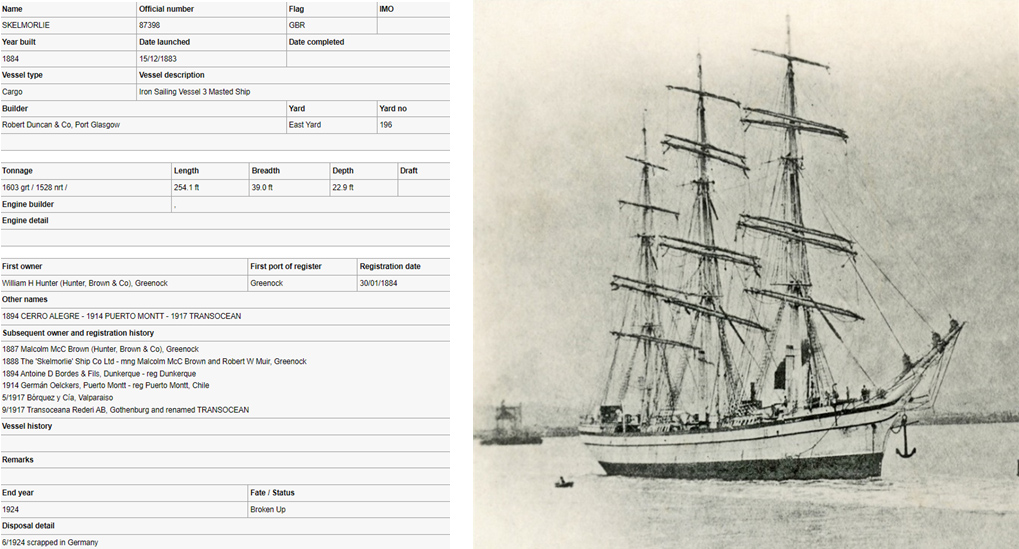
The Skelmorlie
At the time of the 1885 valuation roll, William Hunter is listed as owning and living at Mallowdale. He also appears in both the 1882 and 1886 Post Office County directories under Mallowdale. [12][16]
In 1887, ownership of the “Skelmorlie” (cargo ship) passed to Malcolm McC Brown of Hunter, Brown and Co, presumably William’s previous business partner and in 1888 a new holding company was set up, the ‘Skelmorlie’ Ship company limited, under the joint management of Malcolm McC Brown and Robert W Muir, Greenock. [15}
Author’s note: We’ve found nothing to say what happened to William’s involvement with the Skelmorlie, but presumably he sold his share prior to the new company being established.
In October 1889, the trustees of the late Peter Wright gave notice to William to repay the loan of £1,500 together with the interest accrued of £71, within 3 months or the house would be sold. [17]
We can only assume that William Hunter chose to sell as the house went on the market and the vendors were the Trustees of the late Peter Wright. [19]
According to the articles of roup, the house was first auctioned on 18 March 1890, having been advertised in both the Glasgow Herald and the Ayr Observer in the preceding weeks. The wording of the advert was the same as 10 years previously except the house now had one less dressing room but instead had a large new conservatory. [18][19]
On the day, the upset price of £1,900 was not reached, so a new date was set for 7 May 1890 at a lower price. Again, there was substantial advertising in the weeks running up to the sale in both the Glasgow Herald and the Ayr Observer. [18][19]
Despite the reduced upset price of £1,700, the house again didn’t sell. The next auction was not until 22 January 1891, ‘with an entry date of Whitsun (mid – May) or earlier if desired’. This suggests that Mallowdale may have been rented during the intervening period, with the lease expiring at Whitsun 1891. [18][19]
For the 3rd time, the house didn’t sell and was let out instead. When the house was put up for the fourth time in Feb 1892, the advertisement included the following advisory “The house is let to Mrs Young for 5 years for Whitsunday 1891, with a mutual break at Whitsunday 1893 at a rent of £95”. [18][19]
We also find Mrs Reid Young, listed at Mallowdale in the Post Office County Directory of 1893. [16]
Finally at public roup on the 18th of February 1893, the house was sold for the upset price (£1,700) to Duncan Sillars, Merchant, Ann Street, Glasgow. [18][19][20]
1893 -1903 Mr & Mrs Duncan Sillars
Duncan Sillars was born in Govan, Glasgow in 1865 to Jane (Currie) and Peter Sillars, who was at the time a master mariner in the merchant navy and by the time of his death an export merchant. [21]
In 1887, when he was 22, Duncan married Margaret Wilson Marshall, in Cambuslang. Prior to the marriage, Duncan was living at Benvaren, Pollockshields, and his occupation was Produce Merchant and Ship Owner. [21]
Authors note: We know from a court case heard in the Scottish court of session in 1894, that Duncan Sillars had a 2/64th share in the Ship “Edinburgh” which was built in 1885, registered in Glasgow and sailed at one point to South America. The case was between the captain and some of the owners trying to either force a sale of the ship or it’s purchase. [22]
Margaret who was 26 at the time of the wedding, was the daughter of John Marshall, Iron Tube Manufacturer and Jean Marshall (Cowan) Sillars. The wedding took place at Margaret’s home, the 24 roomed Caldergrove house, near Cambuslang, where the family had been living for at least 12 years. [23][24]

Caldergrove House, courtesy of the Blantyre Project
Two years after the wedding in February 1889, Margaret, gave birth to a baby boy, Ronald Gordon Sillars in Helensburgh. [21]
At the time of the 1891 census, Duncan, Margaret, and Ronald were all staying with Margaret’s parents, now retired) at Caldergrove house. Also present were Margaret’s brother, Robert Cowan Marshall (Iron Tube Manufacturer) and her younger married sister Jessie Reid Sillars. There were 4 live-in servants: a cook, a housemaid, a laundress, and a nurse. [24]
In 1893, Duncan Sillars purchased Mallowdale for the upset price of £1,700. In the same year he took out two secured loans on the property, one for £850 pounds from Abram Lyle, sugar refiner and other Trustees (which included Alexander Park Lyle, shipowner, Malcolm McCaskill Brown, shipowner, Abraham Lyle younger, ship handler and George Macdonald Solicitor, all trustees of the late Mary Lyle) and one for £450 pounds from William Cairns, Engineer and other trustees. [25]
Two years later, following the death of Margaret’s father, Robert Cowan Marshall (her brother) and other trustees, purchased Mallowdale from Duncan Sillars for the sum of £2,000, £700 of which was paid then and there from John Marshall’s estate and the remaining £1,300 by discharging the two outstanding loans. This is line with the 1895 valuation roll, where Mallowdale is owned by Robert Cowan Marshall & other Trustees, with Duncan Sillars as tenant. [25][26]
In 1899, the trustees transferred Mallowdale to Margaret Wilson (Marshall) Sillars ‘in accordance with her father’s wishes’. [26]
It’s not clear whether Duncan, Margaret and Ronald lived at Mallowdale full-time or whether it was just a summer residence. However, the family (Duncan and Margaret then both 36 and their son Ronald then 12) were at home at the time of the 1901 census with three domestic servants in their 20’s from Sutherland and Stirlingshire. [27]
Two further references to the family can be found whilst they still owned Mallowdale. Firstly Duncan Sillars is listed as living at Mallowdale in the 1901 Post Office County Directory and Mr Ronald Sillars, when he is only 16 is only person listed under Mallowdale in the 1903 Slater’s Royal National Directory. [28]
That same year, Margaret sold Mallowdale to Walter Hamilton, merchant, East India Company, Glasgow. The Sillars family moved to a house called Ardgare near Helensburgh. There twelve years later, Duncan died aged 50, his occupation recorded as Export Merchant, like his father before him. Margaret died 7 years later, aged 60. Their son Ronald was informant for both. [21][29]
1903 – 1927 Mr & Mrs Walter Hamilton
Walter Hamilton was born in 1842 in Lanarkshire to Alexander Hamilton, Civil Engineer and Elizabeth (Yeats) Hamilton. [30]
We’ve been unable to discover anything about Walter’s early life and instead pick up his story in 1895 when he married Jessie McKinnon. At the time of the wedding, we learn he is still a bachelor, aged 53, working as a merchant for the East India Company and living in Colombo, Ceylon (Sri-Lanka). Jessie is 40 years old, a widow and living in Hillhead. Her father was John McKinnon, accountant and her mother Margaret (Paul) McKinnon. [30]
After the wedding we again lose sight of the couple, presumably when they return to Sri-Lanka for Walter’s work. We know that when he purchased, Mallowdale in 1903 he gave his address simply as Glasgow. [29]
In the subsequent valuation rolls (1905,1915, 1920 and 1925), Walter was listed as both proprietor and tenant of Mallowdale. In 1905 and 1915, his occupation was recorded as Merchant and the coach house was empty. From 1915, his occupation was recorded as retired merchant and the coach house was occupied by James McIntyre, chauffeur. [31]
We’ve been unable to find references to the couple in either the 1901 or 1911 census, leaving us to assume that they were in Sri Lanka at the time. However, in 1921 Walter, aged 79 and Jessie aged 59, are ‘at home’, in Mallowdale. With them is a cook, Jessie Stevenson, and a table maid Charlotte Elliot. Living in the coach house/Craigview is James and Annie McIntyre.[32]
Jessie Hamilton died at home in 1923, aged 70 with her husband Walter at her side. Four years later, Walter died at home with his sister Elizabeth Yule at his side. [30]
Later that same year the house was sold to Mrs Victoria Margaret Mayberry or MacKay, wife of and residing with Roderick George MacKay, Commercial Manager, ‘Strathyre’, 11 Corrour Road, Newlands, Glasgow for the sum of two thousand, five hundred pounds. [33]
1927 – 1935 Mrs Victoria Margaret Mayberry or MacKay
Victoria Margaret Mayberry was born on March 6, 1888, to Hugh Mayberry, property agent and land valuer and Margaret (Kerr) Mayberry in Cathcart, Glasgow. [34]
She married Rudolph Pierre George Creischer, coal exporter, in Pollockshields in April 1912 when she was 24 and he was 23. His father was Theodore Creischer, yarn merchant and his mother Jane (MacKay) Creischer. A year later in 1913, the couple had a son, Rudolph V Theodore Creischer, born in Hillhead. [34]
At some point over the next 14 years, Rudolph Creischer changed his name to Roderick George MacKay (George being one of his middle names and MacKay his mother’s maiden name) with Victoria and their son doing the same. [34]
Author’s note: Did the family change their names due to anti-German sentiment during/ after WW1?
It was using this new name that Victoria purchased Mallowdale in 1927. [33]
In the 1930 valuation roll, Victoria was shown as owner and George as tenant. The coach house/Craigview was empty. [35]
In 1934, George, aged 45, died in Great Western Road, Glasgow. The death certificate confirmed his name change and gave Mallowdale, Skelmorlie as his usual address. [34]
A year later Victoria sold Mallowdale to Mrs Mabel Annie Miller of Milngavie for the sum of one thousand seven hundred and fifty pounds. [35]
Victoria, moved back to Glasgow and remarried in 1938 when she was fifty. Her second husband was John Wylie, general merchant and agent, a bachelor, aged 49, also living in Glasgow. Victoria went on to have a long life, living to 86. Her final address was in Park Circus, Glasgow. [34]
1935 – 1946 Mrs Mabel Annie Miller
The deeds show that Mallowdale was purchased by Mrs Mabel Annie Miller, wife of Percy Frederic Miller, manager of the Glasgow branch of W.D. and H.O. Wills, branch of the Imperial Tobacco company (of Great Britain and Ireland) Limited and residing at Creagorry, Kersland Drive, Milngavie. [36]
The 1940 valuation roll shows Mrs Mabel A Miller, wife of Percy F Miller, as proprietor and tenant. [37]
When the house sells in 1946, we are given the same information as when it was purchased, i.e. Mrs Miller, wife of Percy Miller, manager of ………Limited and sometimes residing at Craegorry, Milngavie, telling us that Mallowdale was most likely a holiday home. [38]
Authors Note: Our searches of the internet and the statutory births, deaths, marriage registers uncovered no further information about the Millers. This might suggest that the couple were born, married, and died, outside of Scotland as normally it’s easy to find records with slightly unusual first names.
1946 – 1951 Robert John Howatson & Mrs Violet W Battley or Howatson.
Prior to purchasing Mallowdale in March 1946, Robert and Violet Howatson lived in Surbiton in Surrey. They did not own the house for long before Robert in 1949, then living in Bedford, bought out his wife’s half share in Mallowdale. He then sold the whole property to Helen Brown in January 1951. [38][39][40]
1951 – 1951 Mrs Helen Donald Blackhall or Brown
Helen Donald (Blackhall) Brown, wife of John Brown, sometimes of Janetta Street, Clydebank purchased Mallowdale in early January 1951 and sold it for a 30% profit 7 months later in August. As the couple moved back to the same house in Clydebank and took out a mortgage on the property, it’s possible that the couple purchased the house to renovate and sell on. [40][41]
1951 – 1956 James Graeme Davie
The next owner of Mallowdale was James Graeme Davie, Insurance Manager, from Helensburgh. Jamie only stayed for 5 years before selling in 1956. [41][42]
1956 -1957 Robert Hamilton Torrence
Robert Torrence purchased Mallowdale in June 1956 for £2,500 and immediately borrowed £2,100 from James Davie (suggesting they might be friends), securing the loan on the house. At the time of purchase, he described himself as ‘sometime Market Gardener’ and moved from Cardonald in Glasgow. Again, his tenure of the property was very short with Robert discharging the loan and selling the property a mere 10 months later to Andrew Stevenson Wilson, most likely because he moved to Nigeria (new address in deeds). [42][43]
1957 -1962 Andrew Stevenson Wilson
The next owner of Mallowdale was Andrew Stevenson Wilson, Plumber, who was moved from Ralston Paisley. Andrew purchased the property for the same amount as the previous owner, i.e. £2,500. [43]
It was Andrew Wilson who applied to the Earl of Eglinton and Winton in 1961 to waive, allocate and augment the Fue Duty of Mallowdale. The author believes this is a necessary requirement when splitting a property as the original Fue Contract will have referred to a single house and outbuildings to be built on the land. [44]
Mallowdale was divided horizontally into upper and lower properties.
Owners of lower flat after split:
1962 – 1977 Mr James and Mrs Janet Sweeney
1977 – 1978 Herbert Alexander Fraser Russell
1978 – 1988 Mr Allan and Mrs Jean Campbell
1988 – ? Mr & Mrs Hutchison
? – 2004 Mr B and Mrs S Streets
2004 – 2023 Mr John & Mrs Linda Yarr
Owners of Upper Flat after split:
Unknown Unknown
Unknown Doctor Douglas Stanley Charles Weedon (Died age 73 in 1997, Largs.)
? – 2001 Mrs C Gillan
2001 – 2016 Mr John & Mrs Linda Yarr
Sources and References
[1] Mallowdale Papers – Bond and Disposition in security by Mr John Innes in favour the Real Estate Security company 1877
[2] Dictionary of Scottish Architects design report. www.scottisharchitects.org.uk/House for John Innes
[3] Input from previous owners of Mallowdale.
[4] Birth, death and marriage certificates for John Innes and family.
[5] www.anesfhs.org.uk/images/downloads/innes/pdfs/b_29_john_innes_and_catherine_wilson.pdf
[6] 1871 Census and 1875 Valuation Roll
[7] http://portal.historicenvironment.scot/designation/LB50041/The Beeches
8] 1878 Post Office Directory. https://digital.nls.uk/directories/browse/archive/90227047?mode=transcription
[9] Mallowdale Papers – Schedule of intimation, requisition and protest at the instance of the Real Estate Security company (Limited) against John Innes.
[10] Mallowdale Papers – Certificates of advertisement in the Glasgow Herald & the Ayr Observer in Oct 1879, Feb 1880, June 1880 and Feb 1881 and the Daily Mail in June 1880
[11] Articles of Roup of subjects at Skelmorlie belonging to Mr John Innes 1879.
[12] 1881 Census and 1885 valuation roll
[13] Marriage certificate of John Wilson Innes and Georgina Weir, 191 Cumberland Street, Hutchesontown.
[14] Mallowdale Papers – Bond and Disposition in Security by William Hunter Esq., in favour of the Trustees of the late Peter Wright, recorded 7 April 1881.
[15] https://www.clydeships.co.uk/view.php?year_built=&builder=&ref=5721&vessel=SKELMORLIE
[16] Post Office County Directories 1882, 1886, 1893
[17] Mallowdale Papers – Schedule of intimation, requisition and protest at the instance of The Trustees of the late Peter Wright to WH Hunter, 1889.
[18] Mallowdale Papers – Certificates of advertisement in the Glasgow Herald & the Ayr Observer in Mar 1890, May 1890, Jan 1891, Feb 1892 and Feb 1893
[19] Mallowdale Papers – Articles of conditions of Roup and Sale of Mallowdale, Skelmorlie 1891.
[20] Mallowdale Papers – Disposition by Peter Wright (Jnr) in favour of Duncan Sillars (1893
[21] Birth, marriage, and death certificates of Duncan Sillars and family
[22] https://www.casemine.com/judgement/uk/5a8ff82760d03e7f57ebbdce
[23] https://blantyreproject.com/2014/07/history-of-caldergrove-house/
[24] 1875 and 1885 Valuation Rolls and Census for Caldergrove House, Cambuslang
[25] Mallowdale Papers – Loan and discharge documents between Duncan Sillars and Abrahm Lyle and other Trustees, Duncan Sillars and William Cairns and Other Trustees, Duncan Sillars and Robert Cowan Marshall and other Trustees
[26] Mallowdale Papers – Disposition by Duncan Sillars in favour of Robert Cowan Marshall and other Trustees and Disposition between Robert Cowan Marshall to Margaret Wilson Marshall or Sillars
[27] 1901 Census.
[28] Post Office County Directories 1901 and Slater’s Royal National Directory 1903.
[29] Disposition by Mrs Margaret Wilson Marshall or Sillars in favour of Walter Hamilton.
[30] Birth, marriage, and death certificates of Walter Hamilton and family
[31] Valuation rolls for Skelmorlie 1905, 1915,1920 and 1925
[32]1901, 1911 and 1921 census.
[33] Mallowdale Papers – Disposition by the Trustees of the late Walter Hamilton in favour of Mrs Victoria Margaret Mayberry or MacKay.
[34] Birth, marriage and death certificates of Victoria Margaret (Mayberry) MacKay and family
[35] 1930 valuation roll- Skelmorlie
[36] Mallowdale Papers – Disposition by Mrs Victoria Margaret Mayberry or MacKay in favour of Mrs Mabel Annie Miller, June 1935.
[37] 1940 Valuation Roll
[38] Mallowdale Papers – Disposition by Mrs Mabel A Miller in favour of Robert John Howatson and Mrs Violet Winnifred Battley or Howatson, March 1946.
[98] Mallowdale Papers – Disposition by Mrs Violet Winnifred Battley or Howatson in favour of Robert John Howatson, August 1949.
[40] Mallowdale Papers – Disposition by Robert John Howatson in favour of Mrs Helen Donald Blackhall or Brown recorded February 1951.
[41] Mallowdale Papers – Disposition by Mrs Helen Donald Blackhall or Brown in favour of James Greame Davie recorded September 1951.
[42] Mallowdale Papers– Disposition by James Greame Davie in favour of Robert Hamilton Torrance recorded June 1956.
[43] Mallowdale Papers – Disposition by Robert H Torrance in favour of Andrew S. Wilson recorded April 1957.
[44] Reference to Minute of Waiver and allocation and Augmentation of Fue Duty by The Earl of Eglinton and Winton with consents in favour of Andrew S. Wilson recorded April 1961.
[45] Mallowdale Papers – Various dispositions covering the sale and purchase of Mallowdale’s lower flat.
[46] Reference to Minute of Waiver by The Right Honourable Archibald George Montgomerie in favour of Thomas Burns Smith and Mrs Catherine Smith recorded October 1989.



